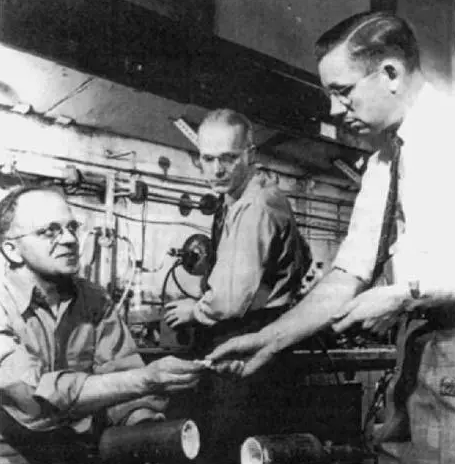PTFE-The unexpected king of materials thuốc hydroxypropyl methylcellulose
PTFE, famously called Teflon, was not a planned exploration. In 1938, DuPont came across this amazing compound quite by mishap, triggering a change in materials science and commercial applications.
One early morning in 1938, Roy Plunkett, a young chemist, was hectic playing with his experiments in a corner of DuPont. His task appeared easy: find a new cooling agent.
(Roy and his colleagues)
Nevertheless, simply when Roy thought it was just a regular job, things deviated. He stored the tetrafluoroethylene gas in a cylinder and claimed to himself: “Okay, see you tomorrow.” The following day, when he went back to continue his experiment, he discovered that the gas had actually inexplicably gone away, leaving just a stack of white powder. Well, this was certainly various from the manuscript he prepared. Imagine his expression during that time: half overwhelmed, half curious. Upon more examination, he found that this weird white powder had some trendy superpowers: it was hostile to almost all chemicals, might remain cool at severe temperature levels, and was as unsafe as oil. Instantly, Luo recognized that while he had yet to find a new cooling agent, he had mistakenly uncovered the secret active ingredient of the cooking area superhero of the future – non-stick frying pans. After that, frying eggs was no longer a difficulty, and cleaning pots became a breeze.
Although the discovery of PTFE was unintentional, it had significant innovative value for the plastics sector and many other fields, such as aerospace, cars, electronics, and appliances. PTFE is widely utilized because of its unique chemical and physical residential or commercial properties – incredibly reduced rubbing coefficient, high-temperature resistance, chemical stability, and non-stickiness. From cooking area tools to vital parts of the space shuttle, PTFE made many innovative applications possible. But while PTFE (Teflon ®) marked an innovative development in materials science, it was only the start of a lengthy and hard road to commercialization and extensive application. The preliminary difficulty was not just to discover a brand-new product however additionally to find out just how to attain large-scale manufacturing and how to apply it in different areas.
The procedures of monomer synthesis and regulated polymerization of PTFE were not completely created, making it difficult to generate PTFE in large quantities or a practical way. While the material’s unique buildings were valuable in the end application, they additionally posed significant challenges throughout the manufacturing process. Unlike other normal plastics, PTFE is not soluble in solvents, acids, or bases and does not melt into a flowable fluid. Instead, when heated up, it comes to be a hard, clear gel that does not thaw and streams like plastics.
(Roy’s Notes: Discovery of PTFE)
To get rid of these difficulties, scientists and designers battled to locate procedures from various other areas, such as adapting strategies from metal and ceramic processing. To shape PTFE, a process called paste extrusion was used, which was borrowed from ceramic handling. Although traditional molding and developing techniques had some problem processing PTFE, it was possible to create PTFE components. By 1947, comprehensive research study and testing had actually borne fruit, and a small production facility was developed in Arlington, New Jacket. This marked the start of Teflon ®’s trip from the research laboratory to the market. In 1950, DuPont opened up a brand-new plant in Parkersburg, West Virginia, significantly expanding the industrial manufacturing of Teflon ®. That very same year, the innovation went across the Atlantic when Imperial Chemical Industries constructed the initial PTFE plant outside the USA in the UK.
Distributor of PTFE Powder
TRUNNANO is a supplier of 3D Printing Materials with over 12 years experience in nano-building energy conservation and nanotechnology development. It accepts payment via Credit Card, T/T, West Union and Paypal. Trunnano will ship the goods to customers overseas through FedEx, DHL, by air, or by sea. If you want to know more about thuốc hydroxypropyl methylcellulose, please feel free to contact us and send an inquiry.
Inquiry us

